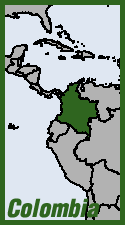 Colombia surpassed Peru last year in land under coca cultivation, resuming its number one position for the first time since 2012. The latest annual report from the UN Office on Drugs and Crime (UNODC) finds that territory under coca cultivation dropped 14% in Peru, from 49,800 hectares in 2013 to 42,900 to 2014—the smallest area under cultivation since 1998. Colombia meanwhile experienced a 44% jump from 48,000 hectares to 69,000. Peru made gains againt coca in the Upper Huallaga Valley, while coca fields expanded in Colombia's Putumayo, Caquetá, Meta and Guaviare regions—all on the frontier lands of plains and rainforest east of the Andes. The findings do not necessarily mean that Colombia is now the world's top cocaine producer, as much of Peru's crop is more mature and higher yielding, having never been subjected to eradication. While Peru eradicates in the Upper Huallaga, it resists US pressure to do so in a second coca cultivation zone, the Apurímac-Ene Valley, for fear of inflaming peasant unrest. (AP, UNODC, July 15; UNODC, July 2)
Colombia surpassed Peru last year in land under coca cultivation, resuming its number one position for the first time since 2012. The latest annual report from the UN Office on Drugs and Crime (UNODC) finds that territory under coca cultivation dropped 14% in Peru, from 49,800 hectares in 2013 to 42,900 to 2014—the smallest area under cultivation since 1998. Colombia meanwhile experienced a 44% jump from 48,000 hectares to 69,000. Peru made gains againt coca in the Upper Huallaga Valley, while coca fields expanded in Colombia's Putumayo, Caquetá, Meta and Guaviare regions—all on the frontier lands of plains and rainforest east of the Andes. The findings do not necessarily mean that Colombia is now the world's top cocaine producer, as much of Peru's crop is more mature and higher yielding, having never been subjected to eradication. While Peru eradicates in the Upper Huallaga, it resists US pressure to do so in a second coca cultivation zone, the Apurímac-Ene Valley, for fear of inflaming peasant unrest. (AP, UNODC, July 15; UNODC, July 2)
There is a sense of deja vú here. In both 2014 and 2013, the UNODC had praised Colombia for gains against coca leaf. The 2012 report harshly scolded Peru for increased cultivation. Colombian gains against coca leaf in recent years as production rose in Peru merely reversed the situation of the 1990s, when gains in Peru pushed production into Colombia—an instance of the so-called "balloon effect." This may be happening again.
Colombian war back on —with a vengeance
Colombia's peace process with the FARC guerillas may also be faltering, with attacks escalating since the rebels ended their unilateral ceasefire on May 22. Two small bombs exploded in Bogotá, on July 2, targetting the offices of a private pension fund—one in the donwtown financial district, the other in a suburb. There were no serious casualties, and no group claimed credit for the attacks, but suspicion of course fell on the FARC. (Al Jzaeera America, July 3)
Far more seriously, a June 22 FARC attack on the Tansandino oil pipeline in Colombia's southwest Nariño region spilled more than 10,000 barrels (400,000 gallons) of crude oil into nearby rivers, streams and mangroves. The water supply was cut off to 160,000 inhabitants of the town of Tumaco. Environment Minister Gabriel Vallejo, who visited the site after the blast, called it "an incalculable tragedy, the worst environmental and social damage done in the past 10 years." Juan Carlos Echeverry, director of state oil company Ecopetrol, said the area will need another 10 years to recover from the damage. Just a week later, with workers still struggling to clean up the spill, guerillas blew up a second section of the pipeline—this time across the mountains in Putumayo region, on the edge of the Amazon rainforest. Little oil was spilled because the pipeline was shut down, but local homes were damaged. On June 16, guerillas attacked another pipeline over the Andes, the Caño-Limon in the north of the country, contaminating the Río Catatumbo and damaging several homes. There was also outrage over a June 8 incident on a road through the jungle in Putumayo, where FARC fighters stopped 19 tanker-trucks and forced them to dump 200,000 gallons of crude, again contaminating local waters. (The Guardian, June 29; Colombia Reports, June 25; PanAm Post, June 19; Colombia Reports, June 8)
At the peace talks in Havana, the FARC delegation responded to criticism over the attacks, saying, "We are not proud of the result of actions against the oil infrastructure, just as we are not proud of the deaths of enemy soliders... in contrast to the joy that the communications media and government spokesmen demonstrate every time they display the deaths of our combatants as trophies." Making a legitimate point for arguably cynical reasons, the statement added: "There is no greater environmental degradation than the 'ecocide' constantly perpetrated by the economic policies of this government, which the FARC is fighting against on a daily basis." (El Tiempo, TeleSUR, June 27)
The FARC also won bad press with a June 12 ambush on a National Police patrol car in Nariño, near the border with Ecuador, killing two police officers and a civilian by-stander. Authorities said one of officers, wounded in the initial attack was finished off with a coup de grace. (VOA, June 17; El Espectador, June 13)
Cross-post to High Times







Recent comments
3 weeks 5 days ago
7 weeks 5 days ago
8 weeks 3 days ago
18 weeks 3 days ago
22 weeks 4 days ago
23 weeks 4 days ago
23 weeks 4 days ago
44 weeks 5 days ago
48 weeks 6 days ago
50 weeks 3 days ago